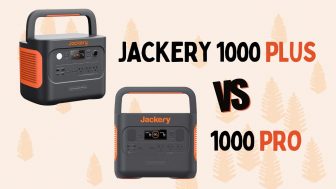
In the world of portable power, two names stand out for their innovation and reliability: Bluetti EB3A and EcoFlow River.
Whether you’re a nature lover who needs a power source for camping, a home prepper looking for backup power in an emergency, or just someone interested in sustainable renewable energy, the choice between Bluetti EB3A vs EcoFlow River is an important one.
But what sets Bluetti EB3A apart from EcoFlow River, and vice versa? Both pack impressive features in a small package, but they are different in some fundamental ways.
In this comparison, we’ll explore the type of lithium batteries they use, storage capacities, charging speeds, outlets and ports, and bonus features like WiFi capability.
Our goal is the uncover their strengths and weaknesses so you can make the right buying decision for your specific requirements.
Bluetti EB3A vs EcoFlow River: How Do They Rate?
Key Takeaways
- Both the Bluetti EB3A vs EcoFlow River are lightweight, portable power stations well suited for camping and having backup emergency power when you need to charge devices like smartphones, LED lights and laptops.
- The Bluetti EB3A features a premium LiFePO4 (Lithium Iron Phosphate) battery, which is known for its longevity, stability and lower risk of flammability.
- The EcoFlow River features an NMC (Nickel Manganese Cobalt) battery, which is known for having higher energy density, but a shorter lifespan.
- The Bluetti EB3A offers a diverse selection of ports, including a wireless charging pad and high-power 24V DC port, while the EcoFlow River provides more AC and DC outputs.
- Both the Bluetti EB3A vs EcoFlow River can be remotely managed using Bluetooth and WiFi connectivity.
About the Bluetti EB3A
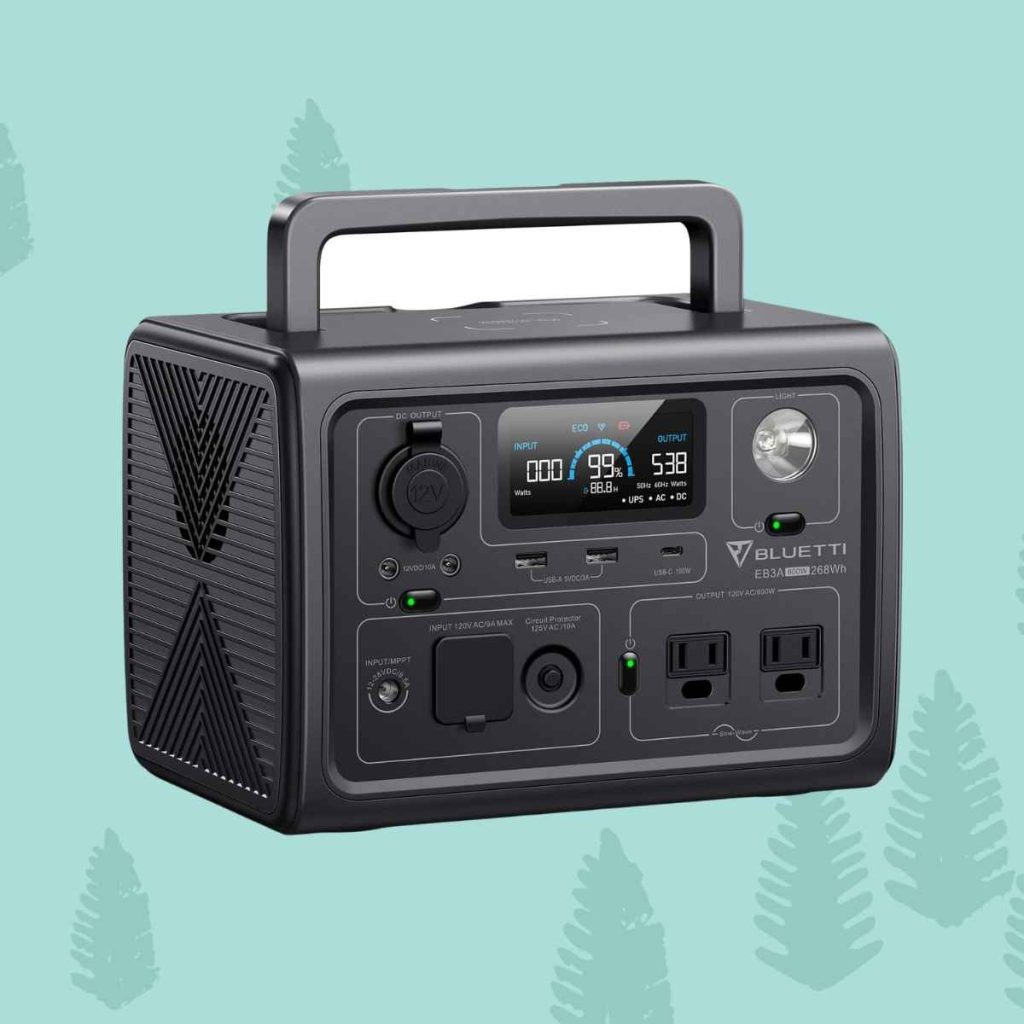
Why do we like the Bluetti EB3A more than the EcoFlow River?
The Bluetti EB3A has a diverse selection of outlets and ports, including a wireless charging pad.
You can connect up to 9 devices to the Bluetti EB3A at the same time, and the power station also has a 15-watt wireless charging pad. The EcoFlow River doesn’t have this option.
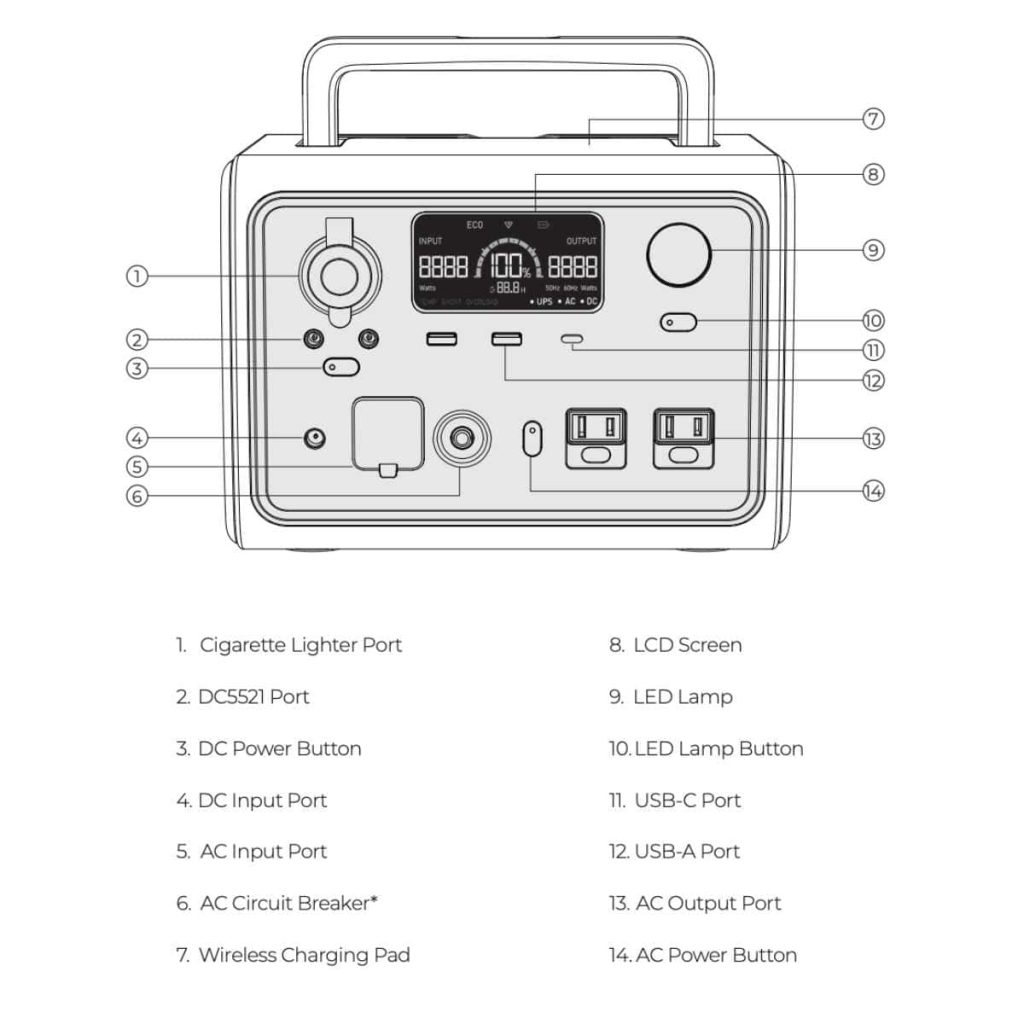
The EB3A outlets and ports include:
- – 2 x 120V/5A AC outlets
- – 2 x DC 5521 (12V)
- – 2 x 5V/3A USB-A ports
– 1 x 100W USB-C port - – 1 x 12V/10A DC port
– 1 x Wireless Charging Pad (15W)
The Bluetti EB3A has a superior LiFePO4 lithium-ion battery.
The Bluetti EB3A has a superior LiFePO4 battery, which is longer lasting, safer and more stable than the EcoFlow River’s NMC battery.
The Bluetti EB3A has 3,000 more charge cycles.
The Bluetti EB3A has a total of 3,000 charge cycles, in comparison to the EcoFlow River’s 500 charge cycles.
The number of charge cycles represent the number of times the power station’s battery can be charged and discharged to 80% before it starts to lose capacity. The more charge cycles a power station has, the longer life span it has.
The Bluetti EB3A is Bluetooth enabled and can be remotely controlled.
The Bluetti EB3A can sync with a smartphone and be remotely managed using the Bluetti APP. The EcoFlow River also has remote APP control.
The Bluetti EB3A has 20ms UPS capability.
The Bluetti EB3A can act as an UPS (uninterrupted power supply) that automatically activates in a power outage. The UPS will transition within 20 milliseconds. This is important for sensitive devices like medical equipment or refrigerators.
Bluetti EB3A Pros and Cons
Performance Reviews
According to customer feedback, the Bluetti EB3A’s real-world tests delivered about 82.1% of its 268.8Wh capacity. This is a little below the usual expectation of 85% for similar models.
Another concern cited by users is the occurrence of the EB3A overheating during charging when the battery is low, which could be a firmware issue.
About the EcoFlow River
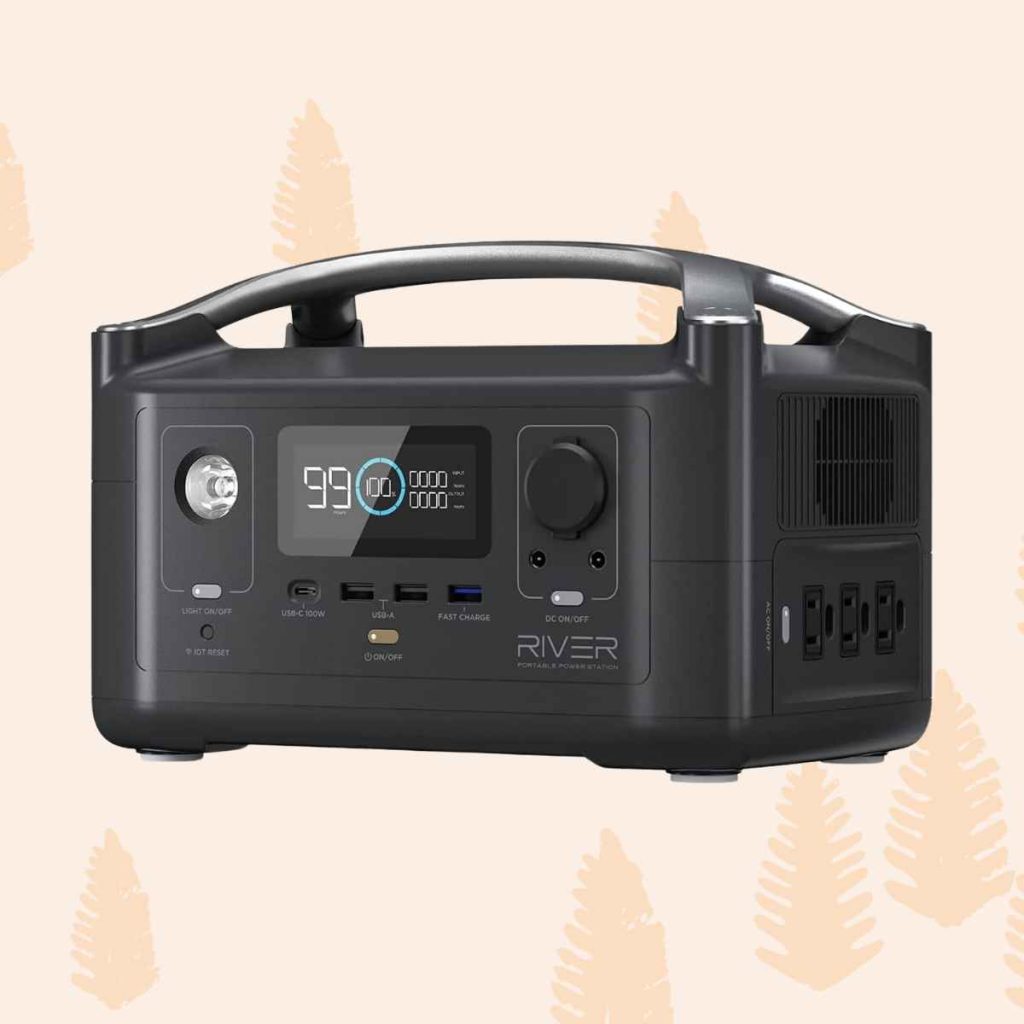
The EcoFlow River can support 10 devices plugged in at once.
The EcoFlow RIVER supports charging up to 10 devices at the same time.
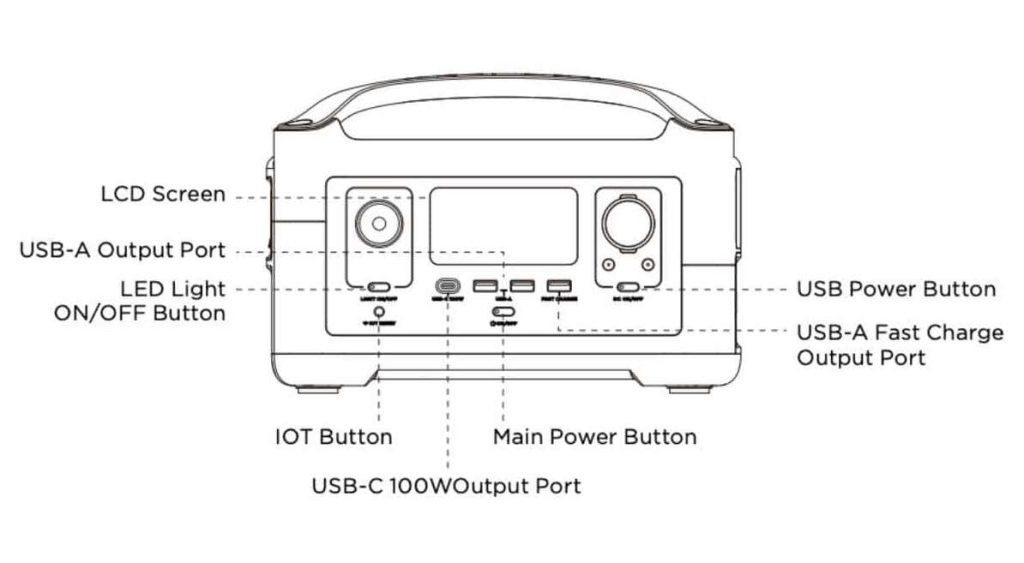
The outlet and port selection includes:
- – 3 x AC outlets
– 3 x DC ports
– 2 x USB-A ports
– 1 x USB-C Fast Charge
– 1 x USB-C PD (100W)
The EcoFlow River has more battery capacity, starting at 288Wh and expandable to 576Wh.
The EcoFlow River has 288Wh of battery capacity that is expandable up to 576Wh.
This means that the EcoFlow River has larger storage capacity than the Bluetti EB3A, and allows you to access more energy when you need it.
The EcoFlow River can recharge to 80% within 1 hour.
In comparison, the Bluetti EB3A takes about 1.8 to 2 hours to recharge via AC outlet, 2.8 to 3.3 hours by solar and 5.3 to 5.8 hours using a 24-volt DC port or 10.1 to 10.6 hours using a 12-volt DC port.
The EcoFlow River has a patented X-Stream feature, so it can get the battery almost fully recharged within 60 minutes using an AC wall outlet. Solar charging takes between 1.6 to 2 hours and charging the DC car port takes about 3.5 hours.
In comparison, the Bluetti takes 1.8 hours to fully charge by AC wall outlet, 2.8 to 3.3 hours by solar charging and anywhere from 5 to 10 hours by DC charging.
The EcoFlow River has more output power, with 1800W peak surge.
The EcoFlow River has 600W AC output, with a tremendous 1800W X-Boost peak surge. This is the River’s most impressive features because it allows you to power energy hungry devices like power tools or kitchen appliances for short periods of time. The X-Boost feature can be accessed through the EcoFlow mobile APP>
In comparison, the Bluetti EB3A has AC output of 600W, and peak surge of 1200W.
The EcoFlow River is WiFi enabled.
The EcoFlow River can connect to a WiFi network. With an internet connection, you can managed the portable power station through the EcoFlow APP, and also receive updates to the power station, including features, optimizations, and security fixes.
EcoFlow River Pros and Cons
Pros: Powerful output, expandable battery, quick recharging, wide selections of outlets and ports, and clear LCD display.
Cons: Not waterproof, NMC battery life is limited to 500 cycles, no wireless charging option.
Bluetti EB3A vs EcoFlow River Comparison Chart
| Features | Bluetti EB3A | EcoFlow River |
|---|---|---|
| Battery Capacity | 268.8Wh | 288Wh (Expandable to 576Wh) |
| AC Charging Time | 1.8 hours | 1.6 hours |
| Solar Charging Time | 2.8 to 3.3 hours | 1.6 to 3 hours |
| DC Charging Time | 5.3 to 5.8 hours (24V) or 10.1 to 10.6 hours (12V) | 3.5 hours |
| Weight and Portability | 10.1 lbs. (4.6 kg) | 11 lbs (5.5 kg) |
| AC Output | 600W (1200W Peak) | 600W (1800W X-Boost Peak) |
| Output Ports | 9 Outputs | 10 Outputs |
| – 2 x AC – 2 x USB-A – 1 x USB-C (100W) – 1 x DC Car Port (12V) – 2 x DC 5521 (12V) – 1 x Wireless Charging Pad (15W) | – 3 x AC – 3 x DC Ports – 2 x USB-A – 1 x USB Fast Charge – 1 x USB-C PD (100W) | |
| Lithium Battery Type | LiFePO4 | NMC |
| Charge Cycles | 2,500 | 500 |
| AC Input | 268W to 430W | 600W |
| Solar Input | 200W | 220W |
| DC Input | 200W | 12V |
| Bluetooth | Yes | No |
| WiFi | No | Yes |
| App Control | Yes | Yes |
| Warranty | 2 Years | 2 Years |
| Noise Level | Unknown | 60dB |
| What’s In the Box? | – Bluetti EB3A portable power station – AC adapter for charging – Car charger – Solar charging cable – User manual | – RIVER 288Wh portable power station – 1.5M AC Charging Cable – 1.5M Car Charging Cable – User manual |
Final Verdict
Battery Type
- The Bluetti EB3A has a better LiFePO4 battery, compared to the EcoFlow River NMC battery. This means the Bluetti EB3A battery will last longer and is less prone to overheating than the EcoFlow River.
Output Power and Peak Surge:
- The Bluetti EB3A and the EcoFlow River both have baseline continuous AC output of 600W.
- In terms of peak surge power, the EcoFlow River delivers 1800W, while the Bluetti EB3A has 1200W surge. This means the EcoFlow River is better for running devices that need a lot of start-up power, like a blender or power tool.
Ports and Outlets:
- The EcoFlow River has a total of 10 outlets, while the Bluetti EB3A has 9.
- The EcoFlow River has 3 AC outlets, while the Bluetti EB3A has 2 AC outlets.
- The EcoFlow River has 4 total USB ports: 2 USB-A, and 2 fast charge USB-C. On the other hand, the Bluetti EB3A has 3 USB ports: 2 USB-A, and 1 fast charge USB-C.
- Both power stations have three (3) 12V/10A DC 5521 outlets.
Charging Options and Recharge Times:
- The EcoFlow River can recharge faster overall, ranging from 1.6 to 3.5 hours, depending on if you use AC, DC or solar.
- In comparison, the Bluetti EB3A takes between 1.8 to 10 hours to recharge, with AC charging being the faster.
Battery Charge Cycles:
- The Bluetti EB3A has 2,500 cycles to 80% original capacity, whereas the EcoFlow River 2 offers 500 cycles to 80% capacity.
- The EcoFlow River 2 charges faster using AC input, taking only 1 hour to fully charge, while the Bluetti EB3A takes slightly longer.
Bonus Features and Warranty:
- The Bluetti EB3A has a wireless charging pad, which is convenient for charging things like smartphones. The EcoFlow River doesn’t have this.
- Both models offer smart app control with Wi-Fi and Bluetooth connectivity.
- The warranty period is 2 years for the Bluetti EB3A and 5 years for the EcoFlow River.
What are the similarities between Bluetti EB3A and EcoFlow River?
The Bluetti EB3A and EcoFlow River are similar in several ways, including starting capacity, AC recharging time, weight and portability, number of ports, APP control and solar input power.
How many charge cycles can Bluetti EB3A and EcoFlow River last?
The Bluetti EB3A has 2,500 charge cycles to 80%, while the EcoFlow River has 500 charge cycles. This means that the Bluetti EB3A battery has more charge / discharge capability and will ultimately have a longer lifespan.
What are the differences in battery capacity between Bluetti EB3A and EcoFlow River?
The Bluetti EB3A has battery capacity of 268.8Wh, while the EcoFlow River capacity starts at 288Wh. However, the EcoFlow River’s battery capacity can be expanded up to 576Wh, which means that it has larger overall storage capacity.
Useful Resources: Bluetti EB3A vs EcoFlow River
Conclusion
In the showdown of Bluetti EB3A vs EcoFlow River the Bluetti EB3A flexes its muscles with a long lasting lithium battery, diverse selection of ports and Bluetooth technology. While the EcoFlow River does provide impressive surge power, the NMC lithium battery is its weakest feature and biggest limitation.
EcoFlow River
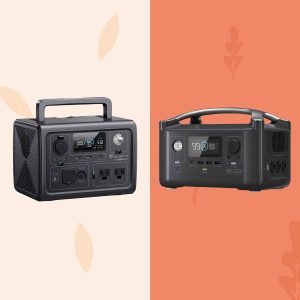
The EcoFlow River portable power station delivers expandable capacity from 288Wh up to 576Wh, 1 hour recharge time when plugged into an AC outlet, and impressive 600W output and 1800W surge power.
Product Brand: EcoFlow
3
Pros
- [object Object]
- [object Object]
- [object Object]
- [object Object]
Cons
- [object Object]
- [object Object]
- [object Object]
Bluetti EB3A

The Bluetti EB3A is a power house in a small package. It features top-notch lithium-ion battery technology, significantly more charge cycles, and bonus features like wireless charging and UPS capability.
Product Brand: Bluetti
4.8
Pros
- Features a premium LiFePO4 battery
- Offers a diverse selection of ports, including a wireless charging pad and high-power 24V DC port
- Bluetooth and WiFi enabled
- Long lasting battery with 3,000 charge cycles
Cons
- Limited power capacity for high-demand appliances
- Only provides two AC outlets
- Recharge time is longer when plugged into a DC port




